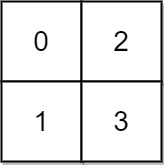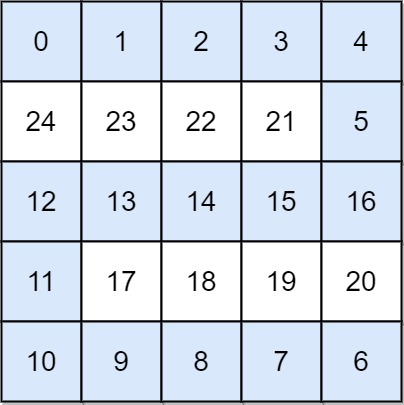Description
You are given an n x n integer matrix grid where each value grid[i][j] represents the elevation at that point (i, j).
The rain starts to fall. At time t, the depth of the water everywhere is t. You can swim from a square to another 4-directionally adjacent square if and only if the elevation of both squares individually are at most t. You can swim infinite distances in zero time. Of course, you must stay within the boundaries of the grid during your swim.
Return the least time until you can reach the bottom right square (n - 1, n - 1) if you start at the top left square (0, 0).
Example 1:

Input: grid = [[0,2],[1,3]] Output: 3 Explanation: At time 0, you are in grid location (0, 0). You cannot go anywhere else because 4-directionally adjacent neighbors have a higher elevation than t = 0. You cannot reach point (1, 1) until time 3. When the depth of water is 3, we can swim anywhere inside the grid.
Example 2:

Input: grid = [[0,1,2,3,4],[24,23,22,21,5],[12,13,14,15,16],[11,17,18,19,20],[10,9,8,7,6]] Output: 16 Explanation: The final route is shown. We need to wait until time 16 so that (0, 0) and (4, 4) are connected.
Constraints:
n == grid.lengthn == grid[i].length1 <= n <= 500 <= grid[i][j] < n2- Each value
grid[i][j]is unique.
Code
Binary Search
Time Complexity: , Space Complexity:
class Solution {
public:
int swimInWater(vector<vector<int>>& grid) {
int n = grid.size();
int l = 0, r = n * n;
while(l <= r) {
int m = l + (r - l) / 2;
vector<vector<bool>> visited(n, vector<bool>(n, false));
if(canSwim(m, 0, 0, grid, visited))
r = m - 1;
else
l = m + 1;
}
return l;
}
bool canSwim(int water, int i, int j, vector<vector<int>>& grid, vector<vector<bool>>& visited) {
int n = grid.size();
if(!(i >= 0 && j >= 0 && i < n && j < n) || visited[i][j] || grid[i][j] > water) return false;
if(i == n - 1 && j == n - 1) return true;
visited[i][j] = true;
return canSwim(water, i + 1, j, grid, visited) || canSwim(water, i, j + 1, grid, visited) || canSwim(water, i - 1, j, grid, visited) || canSwim(water, i, j - 1, grid, visited);
}
};Heap
Time Complexity: , Space Complexity:
heap 幫我們 keep track of the minimum so far until we meet the destination.
class Solution {
public:
int swimInWater(vector<vector<int>>& grid) {
using T = tuple<int, int, int>;
int n = grid.size();
// min heap
auto cmp = [](const auto& t1, const auto& t2) {
return get<0>(t1) > get<0>(t2);
};
priority_queue<T, vector<T>, decltype(cmp)> pq(cmp);
vector<vector<bool>> visited(n, vector<bool>(n, false));
pq.push(make_tuple(grid[0][0], 0, 0));
visited[0][0] = true;
int res = 0;
vector<pair<int, int>> directions = {{1, 0}, {-1, 0}, {0, 1}, {0, -1}};
while (!pq.empty())
{
auto t = pq.top();
pq.pop();
res = max(res, get<0>(t));
int x = get<1>(t), y = get<2>(t);
if (x == n-1 && y == n-1)
{
return res;
}
for (const auto& p : directions)
{
int x_neigh = x+p.first, y_neigh = y+p.second;
if (0 <= x_neigh && x_neigh < n && 0 <= y_neigh && y_neigh < n && !visited[x_neigh][y_neigh])
{
visited[x_neigh][y_neigh] = true;
pq.push(make_tuple(grid[x_neigh][y_neigh], x_neigh, y_neigh));
}
}
}
return 0;
}
};